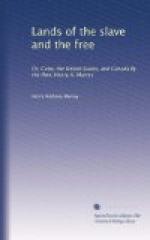The best place for reviewing the Rapids is from the drive leading to the Cemetery, which here, as in most large American towns, is one of the prettiest spots in the neighbourhood; but the Rapids are not only ornamental, they are eminently useful. They afford a water-power to several mills, one of which, the Gallego Flour-Mill, is a splendid establishment, six stories high, nearly one hundred feet square, and capable of sending out daily 1200 barrels of flour. The flour is of very superior quality, the brand fetching a higher price than that of most others in the country. There are also rolling-mills, cotton and tobacco factories; the latter of course in great quantities, as tobacco is one of the chief products of the state, and rapidly increasing. The produce entered in Richmond, which in 1851 was under 16,000 hogsheads, in 1852 amounted to more than 24,000, and is now very probably above 30,000. Virginia has the honour of being the first State that raised cotton, the cultivation whereof was commenced in the year 1662.
Let us pass on to the hill at the eastern extremity of the city, commanding a panoramic view of the river below the town, and all the surrounding country. One spot arrests the attention, a spot closed with the deepest and most romantic interest. A solitary tree, to which no sacrilegious hand has yet dared to apply the axe, stands a few miles down the river, on the same side as the town, and marks the site of the lodge of the venerable old chieftain, Powhattan, when as yet the colony was in its infancy, and when the Indian and the white man—the spoiler and the spoiled—were looking at each other with mutual distrust, deep fear on one side and dark foreboding on the other. The Indian is no more; and nought remains as a memorial of this chief who once ruled this fertile land with absolute sway, except this solitary tree;—and what an episode in the history of colonization does that tree recal! Who can forget that, when despair was the Colonists’ daily bread, when nought but the energy and genius of Smith—a man of very ordinary name, but of no ordinary character—kept hope flickering in its socket, an attack of Indians made him a prisoner, and left them hopeless. Then, how romantic the tale of his captivity! He betrayed no fear, but retained perfect self-possession; and remembering how easy their superstitious minds could be worked upon, he drew forth, and with great solemnity commenced looking steadily at his pocket-compass, and thence to heaven, alternating between the two, until he impressed them with a feeling of awe, as though he were a superior being communing with the Great Spirit. This feeling gradually wearing off, the captors insisted upon his death, as an expiation for the many injuries they had experienced at the hands of the whites. The tribe meet, the block is prepared, the captive’s neck is laid ready, the upraised tomahawk, held by a brawny Indian arm, whose every muscle quivers with revenge, glitters in the sunbeams; swarthy figures




